Have you ever chopped up too many potatoes and wondered what to do with the leftovers? I sure have.
It turns out, storing cut potatoes isn’t as straightforward as I thought.
I’ve learned the hard way that if you don’t store them properly, they can turn brown or even go bad before you get a chance to use them.

But don’t worry, I’ve figured out some foolproof methods to keep those spuds fresh and ready for your next meal.
Highlights
- Water Works Wonders: I found out that submerging cut potatoes in cold water slows down oxidation, keeping them fresh and preventing that unappetizing brown color. It’s a simple trick that makes a big difference.
- Refrigeration Rules: Storing cut potatoes in the fridge, especially if they’re submerged in water, can extend their freshness for a couple of days. It’s a game-changer for meal prep.
- Vinegar for Victory: Adding a splash of vinegar to the water not only keeps the potatoes from browning but also preserves their flavor. Just remember to rinse them before cooking to avoid any vinegar taste.
In this article:
Understanding Potatoes: Starches, Sugars, and Discoloration
When you slice into a potato, you’re breaking cell walls and exposing the potato’s flesh to oxygen. This triggers an oxidation process, which can lead to discoloration.
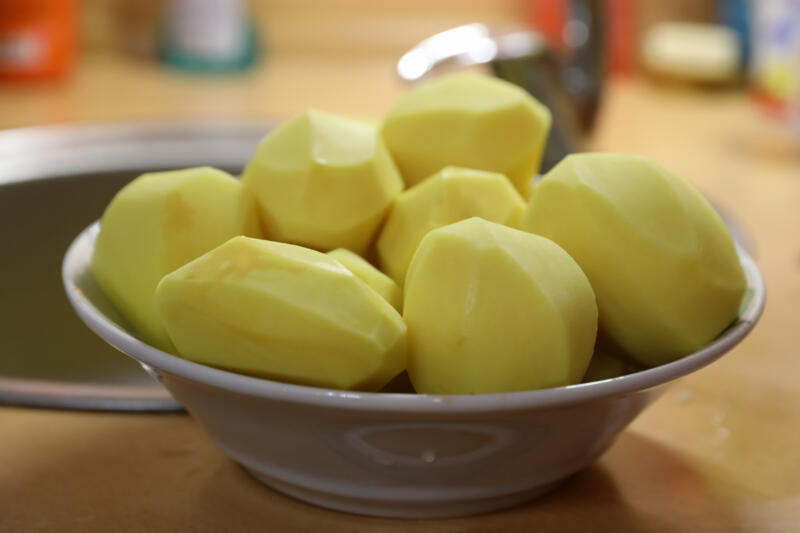
It’s an enzyme called polyphenol oxidase (also known as tyrosinase) that reacts with phenolic compounds in the potato in the presence of oxygen, leading to the formation of melanins, which cause the browning.
This enzymatic browning or greying is a common phenomenon in many fruits and vegetables, including apples, avocados, and potatoes.
While not harmful, this discoloration can make the potatoes less visually appealing.
Beyond their appearance, potatoes are a rich source of starches and sugars, which significantly influence their taste and texture.
The complex carbohydrates, or starches, give cooked potatoes their creamy, hearty texture.
Meanwhile, the sugars contribute to the potato’s slightly sweet flavor and, when roasted or fried, lead to a browning effect due to the Maillard reaction.
Short-Term Storage
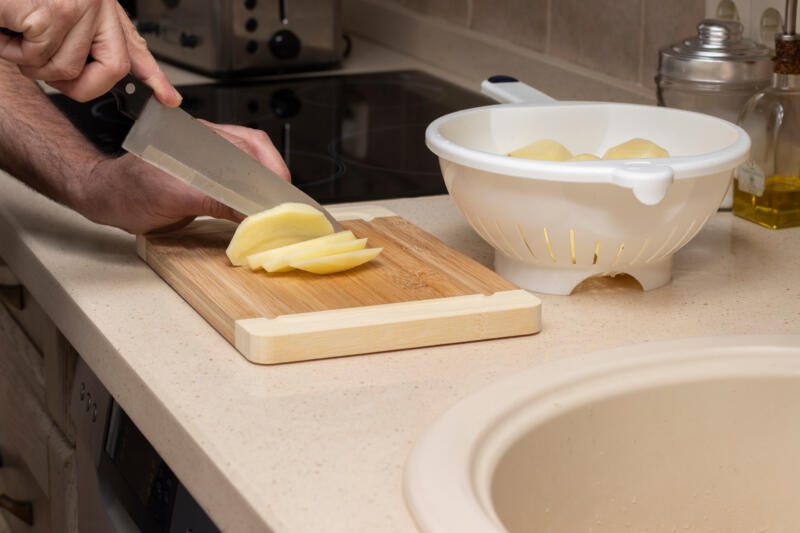
When it comes to the short-term storage of cut potatoes, soaking them in cold water can actually be quite beneficial.
This method not only prevents the potatoes from discoloring due to oxidation but also helps to remove some of the starch content (if you seeking it).
The water leaches out some of the starch from the potatoes, reducing their overall carbohydrate content.
This can be particularly advantageous for people who are trying to manage their blood sugar levels, such as those with diabetes.
However, it’s important to note that while this method can reduce the starch content, it doesn’t eliminate it completely. Despite the reduction in starch, potatoes remain a high-carb food.
Storing Cut Potatoes in a Bowl of Water
One of the simplest and most effective ways to store cut potatoes is in a bowl of cold water.
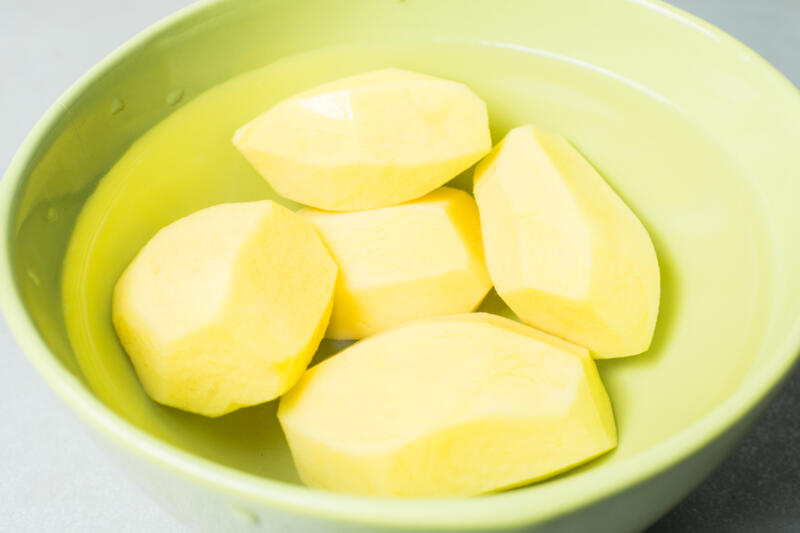
The water acts as a barrier between the potato’s flesh and the air, slowing down the oxidation process and preventing discoloration.
For best results, use a bowl that’s large enough to fully submerge the potatoes and change the water every few hours to keep it fresh.
If you’re planning to store the potatoes overnight or for a couple of days, consider using an airtight container or a sealed plastic bag.
This will help maintain the freshness of the potatoes and prevent them from absorbing odors from other foods in your fridge.
Refrigeration of Cut Potatoes
Keeping sliced potatoes in the fridge serves as a practical approach for brief storage periods.
A chilled setting reduces the rate of oxidation, ensuring the potatoes retain their natural color and taste.
Ideally, raw potatoes should be stored at a temperature of around 4°C (39°F).
In terms of how long you can store cut potatoes in the fridge, it largely depends on how they’re stored.
If they’re submerged in water in an airtight container, they can last for several days.
However, if they’re left uncovered, they may start to discolor within a few hours.
Using Vinegar to Preserve Color and Flavors
A little-known trick for preserving the color and flavor of cut potatoes is to add a splash of vinegar to the water.
The acidity of the vinegar helps to slow down the oxidation process, keeping your potatoes looking and tasting fresh.
Just remember to rinse the potatoes before cooking to remove any residual vinegar taste.
Long-Term Storage
Freezing
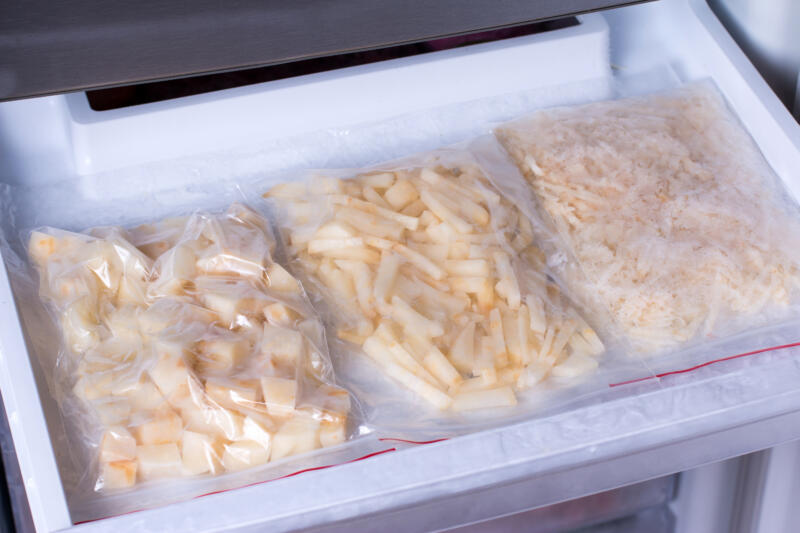
Freezing is a great option for long-term storage of cut potatoes.
To prepare potatoes for freezing, first wash and peel them (if desired), then cut into your preferred size.
Blanch the cut potatoes in boiling water for a few minutes to deactivate enzymes that cause discoloration, then cool quickly in ice water.
Drain well and freeze on a baking sheet before transferring to a freezer bag or container.
Frozen potatoes maintain a good texture and taste, especially when used in cooked dishes like soups, stews, or casseroles.
However, they may not be as crisp as fresh potatoes when roasted or fried due to the breakdown of cell structures during freezing.
Dehydrating
Dehydration is another method for long-term storage of cut potatoes.
This process involves removing the water content from the potatoes, which inhibits the growth of bacteria and slows down oxidation.
To dry out potatoes, clean, skin, and cut them into thin slices.
Blanch in boiling water, then arrange on dehydrator trays and dry at the recommended temperature until crisp.
Dehydrated potatoes can be soaked for cooking purposes or munched on as a crispy delight.
Dehydration can affect the starches and sugars in potatoes, often intensifying their natural sweetness. However, the texture will be significantly different from fresh potatoes.
Storing Whole Potatoes
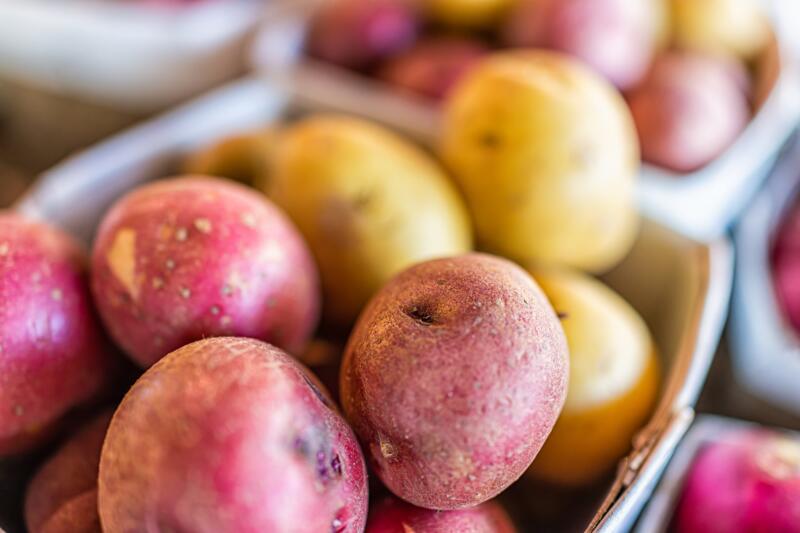
For whole potatoes, storing them in a cool, dark place in a paper bag can help them last for several months.
The paper bag allows air circulation, which can prevent moisture buildup and subsequent rot.
Considerations for Different Types of Cut Potatoes
Sweet Potatoes: Dealing with Excess Starch

Sweet potatoes have a higher sugar content and can be more prone to discoloration.
Storing them in water with a splash of lemon juice can help maintain their vibrant color.
Russet Potatoes: Maintaining the Potato Skin
Russet potatoes have a thick skin that can protect the inner flesh.
If you’re storing cut russets, leave the skin on whenever possible to help preserve freshness.
Red Potatoes: Preserving the Color
Red potatoes have a waxy texture that holds up well in water. Store cut red potatoes in a bowl of cold water in the fridge to preserve their color and texture.
Cover the bowl with plastic wrap to further protect the potatoes from exposure to air.
Baking Potatoes: Keeping Them Ready for Baking
Baking potatoes are often larger and can be stored whole until ready to use. If cut, store in cold water in the fridge, covered with plastic wrap, and use within a day or two to maintain the best texture for baking.
Peeled Potatoes: How to Keep Them Fresh
Oxidation can cause peeled potatoes to discolor rapidly.
To maintain their freshness, immerse them in cold water and store in the fridge.
While covering them with plastic wrap can help, an even better option is to store them in an airtight container.
Regardless of the method, for optimal quality, use them within 24 hours.
Storing Cut Potatoes for Specific Dishes
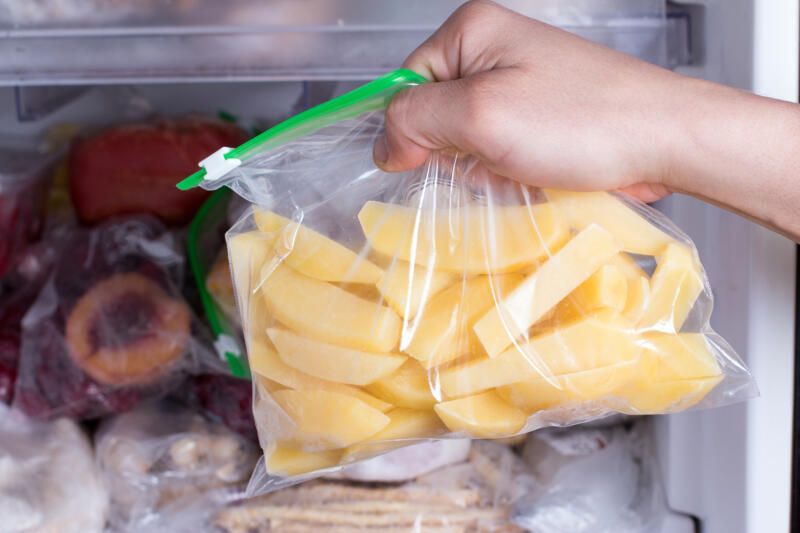
Potatoes for Fries: Dealing with Potato Slices
When storing cut potatoes for fries, it’s important to keep them submerged in cold water.
This not only prevents discoloration but also helps toremove excess starch, which can make your fries crispier.
If you’re preparing fries a day ahead, store the potato slices in the fridge in an airtight container filled with water.
Ensure you dab them dry completely before frying to prevent oil from splashing.
Potatoes for Mashed Potatoes: Managing the Starch Content
For fluffy, creamy mashed potatoes, you need to maintain a certain level of starch.
While soaking cut potatoes in cold water can help remove some surface starch and prevent discoloration, it doesn’t eliminate the internal starch that contributes to the desired texture.
If you’re prepping ahead, store the cut potatoes in water in the fridge for up to a day. Before cooking, drain and rinse them to remove any excess surface starch.
Potatoes for Roasting: Maintaining Flavors
For roasting, it’s all about preserving the potato’s natural flavors.
If you’ve cut your potatoes in advance, store them in a bowl of cold water in the fridge to prevent discoloration.
However, be sure to pat them dry before roasting to ensure a crispy exterior.
If you’ve seasoned your potatoes ahead of time, store them in an airtight container in the fridge to marinate.
Storing Cooked Potatoes
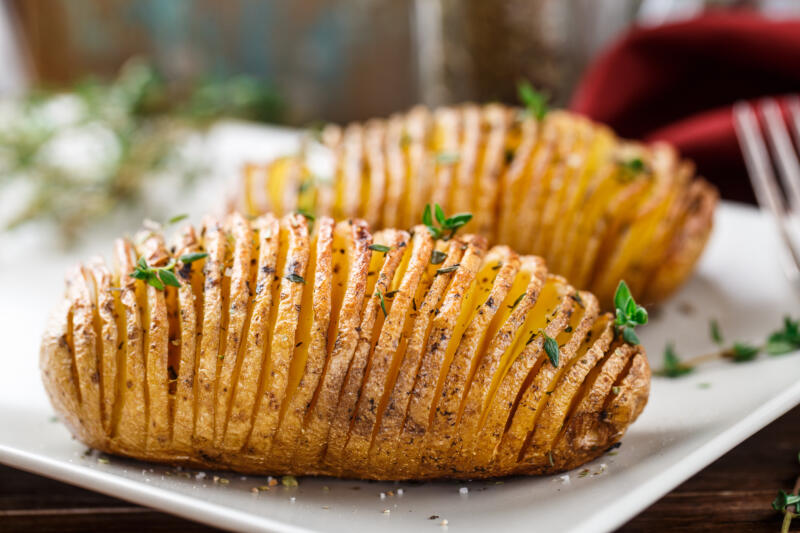
How to Store Potato Salad: Keeping the Vegetables Fresh
Potato salad should be stored in an airtight container in the refrigerator.
The cold temperature will help keep the vegetables fresh and the flavors intact. It’s best to consume potato salad within 3-4 days for optimal freshness.
Storing Other Cooked Potato Dishes: Maintaining Flavors and Textures
Other cooked potato dishes, such as mashed potatoes, roasted potatoes, or potato casseroles, should also be stored in airtight containers in the refrigerator.
These dishes can typically last up to 5 days in the fridge.
To reheat, use the oven or stovetop for dishes like roasted potatoes or casseroles to maintain texture, and the microwave for mashed potatoes.
Always ensure the dish is heated thoroughly before consuming.
FAQs
Can I Cut and Store Potatoes Ahead of Time?
Absolutely! Cutting and storing potatoes ahead of time can be a great time-saver.
The key is to store them properly to prevent discoloration and maintain freshness.
Submerging cut potatoes in cold water and storing them in the fridge is a common method.
How Long Can Cut Potatoes Sit in Water?
Cut potatoes can sit in water for about 24 hours before they start to lose their structural integrity.
If you’re planning to store them longer than a few hours, it’s best to keep them in the fridge to slow down the oxidation process.
Can You Cut Up Potatoes and Leave Them in the Fridge?
Absolutely, you can slice potatoes and store them in the refrigerator. Just ensure they’re kept in a sealed container or zip-lock bag to keep them from taking on the smells of other foods.
If possible, submerge them in water to prevent discoloration.
How Do You Store Unpeeled Cut Potatoes?
Unpeeled cut potatoes can be stored in the same way as peeled ones.
Submerge them in a bowl of cold water and store in the fridge to prevent discoloration. The skin can provide some protection against oxidation.
How Long Can You Keep Cooked Potatoes in the Fridge?
Cooked potatoes can be stored in the fridge for about 3-5 days. Ensure you keep them in a sealed container to preserve their taste and texture.
Conclusion
Storing cut potatoes properly is an essential skill for any home cook or professional chef.
It not only helps maintain the quality of your potatoes but also allows you to prepare meals more efficiently.
Whether you’re storing them for a few hours or a few days, there are several methods you can use, from simple water storage to more complex methods like freezing or dehydrating.
So, why not test out these techniques?
If you have any questions or comments, feel free to share them below. We’d love to hear from you!